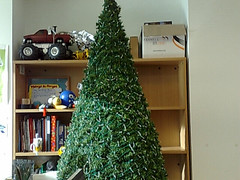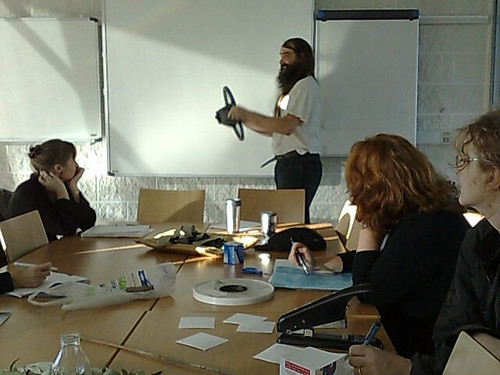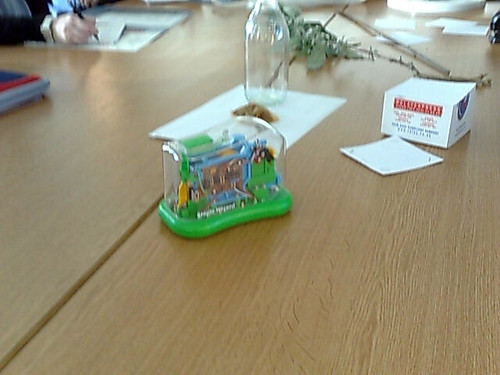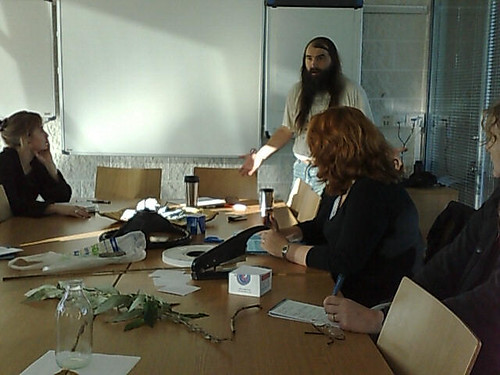Firefly will be featured in a special science series on BBC North West Tonight this evening sometime between 6:30 and 7 (SKY channel 978 if you are not in the North West!).
Tag Archives: firefly
when virtual becomes real
Just read Adam Greenfield’s blog entry “Reality bites“. He describes how a design he produced for a friend’s new restaurant became a solid metal sign within days. Despite knowing about recent rapid fabrication techniques, actually seeing these processes in action for his own design was still shocking.
I too am still amazed at the relative ease that ideas can be turned into reality. In a presentation “As we may print” at the 2003 Interaction Design for Children, Michael Eisenberg described how he and his co-workers at University Colorado were using laser cutters to enable children to design their own 3D designs in card or even thin plywood. More recently at the National Centre for Product Design and Development Research in Cardiff, I saw 3D metal printers. I was aware of 3D printers working in various gels and foams, but did not realise it was possible to create parts in titanium and steel, simply printed from 3D CAD designs. Chasing one of Adam’s links I found instructions to make your own 3D printer on the MIT site … however, this constructs your designs in pasta paste not metal!
One of the arguments we are making about our FireFly technology is that it will change lighting from being a matter of engineering and electronics, to a digital medium where the focus moves form hardware to software. While FireFly allows more flexible 2D and 3D arrangements than other technologies we are aware of, it is certainly not alone in making this transformation in lighting. Last week I was talking to Art Lights London and they are planning some large installations using Barco’s LED lighting arrays. Soon anything that you can point on your computer screen you will also be able to paint in light from your own Christmas tree to London Bridge.
Although it sometimes seems that technology is simply fuelling war and environmental catastrophe, it is a joy to still glimpse these occasional moments of magic.
Christmas lights and crackers
 The lights are on in Lancaster City Centre. After three years FireFly has its first real public outing. You can see them now and for the next few months in Dalton Square in the centre of Lancaster.
The lights are on in Lancaster City Centre. After three years FireFly has its first real public outing. You can see them now and for the next few months in Dalton Square in the centre of Lancaster.
The initial idea for FireFly came after a meeting where we had been discussing various forms of public displays. For some reason, a thought struck – those tiny lights  that you see in trees outside hotels and in city centres throughout the year; what if you could turn those into a display?
that you see in trees outside hotels and in city centres throughout the year; what if you could turn those into a display?
That was in early 2004 and now after several years of Joe Finney’s ingenuity and Angie Chandler’s hard work, they are here. Behind each of the three thousand lights in the CityLab display is a microprocessor as fast as my first PC! If you are near Lancaster in the next few months do go see them, they are just by the City Hall, under the beady eye of Queen Victoria’s statue.
 In another bit of Christmas technology, this year I ported crackers to facebook. The good old virtual crackers are still there, but now you can also send facebook crackers 🙂 Mostly this was a straight port, but there are interesting differences because of the way facebook works as a platform. I’ve been watching the stats I collect and it is interesting to see that whilst around 2/3 of email crackers are opened only about 1 in 5 are opened in facebook. I guess with so much food being thrown and the like, facebook users are far more used to ignoring things :-/
In another bit of Christmas technology, this year I ported crackers to facebook. The good old virtual crackers are still there, but now you can also send facebook crackers 🙂 Mostly this was a straight port, but there are interesting differences because of the way facebook works as a platform. I’ve been watching the stats I collect and it is interesting to see that whilst around 2/3 of email crackers are opened only about 1 in 5 are opened in facebook. I guess with so much food being thrown and the like, facebook users are far more used to ignoring things :-/
Links: Lights in City Lab | Crackers on Facebook | Email Crackers
matterealities and the physical embodiment of code
Last Tuesday morning I had the pleasure of entertaining a group of attendees to the Matterealities workshop @ lancaster. Hans and I had organised a series of demos in the dept. during the morning (physiological gaming, Firefly (intelligent fairylights), VoodooIO, something to do with keyboards) … but as computer scientists are nocturnal the demos did not start until 10am, and so I got to talk with them for around an hour beforehand :-/
The people there included someone who studied people coding about DNA, someone interested in text, anthropologosts, artists and an ex-AI man. We talked about embodied computation1, the human body as part of computation, the physical nature of code, the role of the social and physical environment in computation … and briefly over lunch I even strayed onto the modeling of regret … but actually a little off topic.
physicality – Played a little with sticks and stones while talking about properties of physical objects: locality of effect, simplicity of state, proportionality and continuity of effect2.
physical interaction – Also talked about the DEPtH project and previous work with Masitah on natural interaction. Based on the piccie I may have acted out driving when talking about natural inverse actions
ubiquity of computation – I asked the question I often do “How many computers do you have in your house” … one person admitted to over 10 … and she meant real computers3. However, as soon as you count the computer in the TV and HiFi, the washing machine and microwave, central heating and sewing machine the count gets bigger and bigger. Then there is the number you carry with you: mobile phone, camera, USB memory stick, car keys (security codes), chips on credit cards.
 However at the Firefly demo later in the morning they got to see what may be the greatest concentration of computers in the UK … and all on a Christmas Tree. Behind each tiny light (over 1000 of them) is a tiny computer, each as powerful as the first PC I owned allowing them to act together as a single three dimensional display.
However at the Firefly demo later in the morning they got to see what may be the greatest concentration of computers in the UK … and all on a Christmas Tree. Behind each tiny light (over 1000 of them) is a tiny computer, each as powerful as the first PC I owned allowing them to act together as a single three dimensional display.
embodiment of computation – Real computation always happens in the physical world: electrons zipping across circuit boards and transistors routing signals in silicon. For computation to happen the code (the instruction of what needs to happen) and the data (what it needs to happen with and to) need to be physically together.
The Turing Machine, Alan Turing’s thought experiment, is a lovely example of this. Traditionally the tape in the Turing machine is thought of as being dragged across a read-write head on the little machine itself.
However … if you were really to build one … the tape would get harder and harder to move as you used longer and longer tapes. In fact it makes much more sense to think of the little machine as moving over the tape … the Turing machine is really a touring machine (ouch!). Whichever way it goes, the machine that knows what to do and the tape that it must do it to are brought physically together4.
This is also of crucial importance in real computers and one of the major limits on fast computers is the length of the copper tracks on circuit boards – the data must come to the processor, and the longer the track the longer it takes … 10 cm of PCB is a long distance for an electron in a hurry.
 brain as a computer – We talked about the way each age reinvents humanity in terms of its own technology: Pygmalion in stone, clockwork figures, pneumatic theories of the nervous system, steam robots, electricity in Shelley’s Frankenstein and now seeing all life through the lens of computation.
brain as a computer – We talked about the way each age reinvents humanity in terms of its own technology: Pygmalion in stone, clockwork figures, pneumatic theories of the nervous system, steam robots, electricity in Shelley’s Frankenstein and now seeing all life through the lens of computation.
This withstanding … I did sort of mention the weird fact (or is it a factoid) that the human brain has similar memory capacity to the web5 … this is always a good point to start discussion 😉
While on the topic I did just sort of mention the socio-organisational Church-Turing hyphothesis … but that is another story
more … I recall counting the number of pairs of people and the number of seat orderings to see quadratic (n squared) and exponential effects, the importance of interpretation, why computers are more than and less than numbers, the Java Virtual Machine, and more, more, more, … it was very full hour
- I just found notes I’d made for web page in embodied computation 5 years ago … so have put the notes online[back]
- see preface to Physicality 2006 proceedings[back]
- I just found an online survey on How many computers in your house[back]
- Yep I know that Universal Turing machine has the code on the tape, but there the ‘instructions’ to be executed are basically temporarily encoded into the UTM’s state while it zips off to the data part of the tape.[back]
- A. Dix (2005). the brain and the web – a quick backup in case of accidents. Interfaces, 65, pp. 6-7. Winter 2005.
http://www.hcibook.com/alan/papers/brain-and-web-2005/[back]



